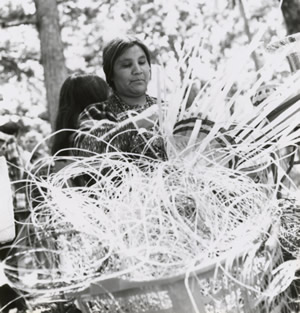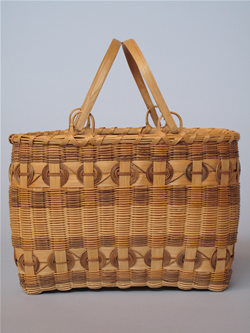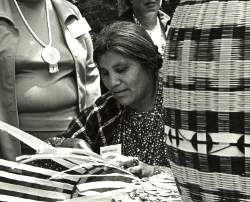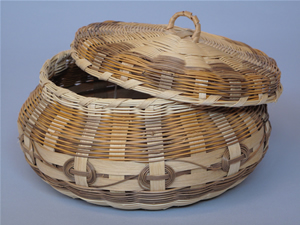People: Nancy Conseen
Nancy Conseen (1929-1997) was born in Cherokee, North Carolina on the eve of the Great Depression. When she was just six years old, she learned to weave white oak and honeysuckle baskets from her mother, Caroline Conseen. In school she learned basket weaving from Lottie Stamper. As an adult and accomplished basket weaver, Nancy Conseen became active in the arts and crafts community beyond the Qualla Boundary. Besides the many ribbons that she won at the annual Cherokee Indian Fair, she won state and national level awards. In 1981, she was selected North Carolina Craftswoman of the Year.
Nancy Conseen was born August 12, 1929 in Cherokee, North Carolina. Her mother, Caroline Conseen, was also a basket weaver. Like many Cherokee, she learned to make baskets in the traditional way.
I was very young when I started making baskets, about six as I recall. I learned how to make honeysuckle, ribbed and white oak splint baskets as a youngster….Along about sixth grade, I learned how to make rivercane baskets from Lottie Stamper, my instructor. 1
Growing up in the Depression, Conseen made and sold baskets to supplement her family’s income. She recalled, “I don’t remember how much money my mother received for any of my baskets, but it wasn’t very much.” Still, it was “enough for my family’s necessities,” she said. 2 While Conseen was able to master three different forms of basket weaving—white oak, honeysuckle, and rivercane—she made honeysuckle her specialty.
The weaving of a Cherokee basket begins with gathering and preparing materials, a process that sometimes takes longer than the actual basket construction. Every fall, Nancy Conseen gathered basket making materials. Given its pliable nature, honeysuckle vines must be woven over a rigid framework to give shape to a basket. The Cherokee traditionally weave honeysuckle over white oak ribs. Basket weavers must collect and prepare both the honeysuckle vine and white oak in preparation for making a honeysuckle basket.
I get my own white oak. I climb all over these mountains looking for white oak. I look until I find the tree I want and can usually tell by the bark of a tree. You usually ruin more trees by cutting out a chip. When I chip a tree, I test the wood by pulling it off at the grain, and if it pulls off easily, the tree is good for weaving baskets. If a tree is left to grow after a chip has been cut, the tree turns brown. Only a small portion of good fiber from a chipped tree can be used for weaving. 3
While Conseen made baskets in the traditional Cherokee way, she did not hesitate to use more modern methods when they were needed. She described gathering and preparing honeysuckle.
When me and my girls gather honeysuckle vines, it takes about six hours. Then the vines are boiled and soaked in Clorox to bleach them white. I use native dyes for dyeing my vines and splints. The foundations of my baskets are white oak and woven into shape with honeysuckle vines. 4
While many basket makers prepared their materials out-of-doors, Conseen used her kitchen. She removed the outer bark of the honeysuckle by boiling the vines in a pressure cooker set on an electric stove. She also used the cooker to prepare dye materials, finding she saved time with this method. In spite of these changes to the method of preparation, Conseen remained a traditionalist. She used bloodroot and walnut tree bark to color her basket materials and wove many traditional forms.

Nancy Conseen beginning the white oak framework for a honeysuckle basket |

Honeysuckle purse basket by Nancy Conseen |
As an adult and accomplished basket weaver, Conseen was active both on and off the Qualla Boundary. She won numerous first prize ribbons at the annual Cherokee Indian Fair and, in 1976, she was included in a Documentary of Six Cherokee Artists, an exhibit inaugurating the renovation of Qualla Arts and Crafts Mutual. She twice won the first prize at the North Carolina State Fair in Raleigh and was selected as Craftswoman of the Year in 1981. Conseen participated in the 1982 World’s Fair in Knoxville, Tennessee. She taught workshops at Warren Wilson College in Asheville, North Carolina and exhibited her work with the Southern Highland Craft Guild. Besides the work she did throughout North Carolina, Conseen’s work took her to fairs and festivals beyond her home state. She traveled, often with her daughters, to New Mexico, New Jersey, Ohio, Tennessee, and Washington DC. Her work twice appeared at the White House. In 1977, First Lady Rosalyn Carter selected her baskets as centerpieces for a White House dinner and, in 1984, she made a “jelly bean basket” for President Ronald Reagan’s 73rd birthday. 5 She also regularly demonstrated at the Oconaluftee Indian Village in summer. In 1994, she and her daughter, Pamela were featured in the 1994 video documentary, Cherokee Artists: The Basket Weavers.
Above and beyond a focus on her own work, Conseen was concerned that the legacy of Cherokee basketry would be passed on through her family. Her two sons and four daughters all learned the craft. Daughter Pamela Conseen Adams recalled that her mother “made me promise my daughters would weave.” She considered the request an “awesome responsibility,” but one she intends to carry on. 6
Anna Fariello
Excerpted from Cherokee Basketry: From the Hands of our Elders,
Published by The History Press, 2009
1. "Documentary of Six Cherokee Artists," Mollie Blankenship and Stephen Richmond, Contemporary Artists and Craftsmen of the Eastern Band of Cherokee Indians: Promotional Exhibits, 1969-1985 (Cherokee, NC: Qualla Arts and Crafts Mutual, Inc, 1987) 67.
2. Blankenship and Richmond, 67.
3. Blankenship and Richmond, 67.
4. Blankenship and Richmond, 67.
5. "Nancy Conseen" member file, in the collection of the Southern Highland Craft Guild, available from http://craftrevival.wcu.edu
6. Pamela Conseen Adams interview by Anna Fariello, July 27, 2009.




